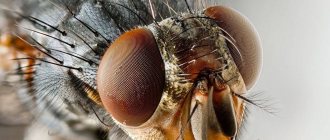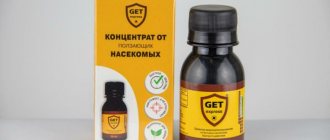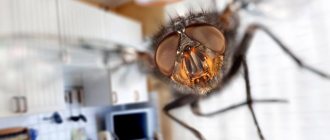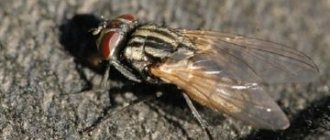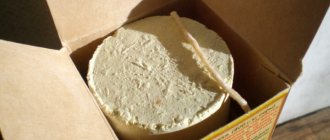The order of Diptera surprises with the variety of representatives. A close relative of the common fly is the ktyr, a ruthless hunter of small and medium-sized insects. A strong body, strong limbs with spikes, a tough proboscis and poison - nature has armed the predator with all this. The moth fly lives all over the world, excluding Antarctica. The exterminator of annoying insects provides a great service to people. But the widespread use of insecticides threatens the existence of beneficial species, some of which are included in the Red Book.
Description
Ktyr is a large family of winged predators. The genus Asilidae belongs to the order Diptera, suborder Short-whiskered. The family of ktyri arose back in the Mesozoic era; today it has more than 7,000 species. A characteristic feature of the structure of the imago is a massive mesothorax and an elongated abdomen. The body shape depends on the species, but in any case it is elongated and cylindrical. Insects living in temperate climates reach a length of 3-50 mm, representatives of tropical species grow up to 80 mm.
The color of the predator is most often black; there are species with brown, reddish or red sclerites. The body is covered with gray pollen; some individuals have a pattern of light stripes and spots. The head is large, almost spherical in shape. Most of its lateral surface is occupied by complex compound eyes. The forehead is depressed, and there are three simple ocelli on the crown. The antennae are shortened. The lower part of the face grows bristles called a beard. They cover the proboscis. This structure helps protect the organ from damage if the victim fights back.
Interesting fact. The head and chest of the ktyri are connected by a movable neck. Some insects can turn their heads 90°.
The strong, developed muscles of the mesothorax provide powerful flight and the ability to capture prey with its limbs. In most species, this part of the body is covered with bristles, hairs and pollen. The wings are well developed, their color varies from transparent to red, brownish and black. The legs are long, massive, covered with bristles. The photo shows that the limbs of the ktyr are adapted by nature to capture and hold prey. Males may have a cluster of contrasting black and white hairs on the fore tibiae.
Beneficial insects. Poisonous fly Ktyr
10/24/2018 This predatory insect represents the order of Diptera of the suborder Short-whiskered and is a close relative of the most common fly.
The ktyri family was formed during the Mesozoic era and has more than 7,000 different species, some of which today, unfortunately, are endangered and are listed in the Red Book.
Ktyr ( lat. Asilidae
) is a ruthless winged hunter of small insects.
It is best characterized by its English names: “ robber fly
” or “
assassin fly
” (“robber fly” and “killer fly”).
Most of the flying insects on our planet have four wings of various lengths and shapes, but in comparison with them, the two-winged bird is simply an ace pilot. It has a lightning-fast reaction and extraordinary gluttony, while the insect’s unique visual organs allow it to notice a food object at a great distance.
Ktyr attacks prey with amazing speed and accuracy, both in the air and on the ground, killing it with poison. In this case, the size of the prey can significantly exceed the size of the predator itself.
The objects of insect hunting can be mosquitoes, midges, flies, grasshoppers, dragonflies, beetles, butterflies and even wasps and bees.
Description of the insect
Ktyr usually prefers to live in dry and well-warmed places by the sun, but occasionally it is also found in forested areas.
The adult fly has a strong muscular body with a massive cylindrical mesothorax and an elongated abdomen. The tenacious legs have sharp spines at the end that hold prey well. The predator has a rigid proboscis and poisonous glands, which allow the insect to quickly kill its prey.
The insect's head is large, almost spherical in shape, its eyes are faceted, large and convex.
The wings are well developed, and their color can be transparent, brownish or black.
The abdomen contains eleven segments, which in males end in the genitalia, and in females in the ovipositor.
Poisonous flies that live in temperate climates are usually of medium size (from 5 millimeters), although larger individuals are also found, while their tropical relatives are often simply gigantic in size, sometimes reaching eight centimeters in length.
All representatives of this family, as a rule, have a nondescript dark-grayish or slightly colored (reddish or reddish) color. At the same time, the entire body of the insect is covered with hairs and strewn with fine gray pollen.
It is noteworthy that the chest and head of the insect are connected by a very mobile neck, thanks to which the predator can turn its head 90 degrees.
Ktyr usually occupies areas well warmed by the sun, with various elevations (stones, protruding tree branches, stumps, other objects), from where it vigilantly observes what is happening in the surrounding area. Seeing a potential victim, the insect takes off sharply, grabbing it with its tenacious legs, and immediately pierces its proboscis, through which poisonous saliva is injected into the victim’s body. It contains a potent neurotoxin poison and proteolytic enzymes that instantly paralyze the insect, while liquefying its internal tissues.
The insect tries to strike with its trunk in the most vulnerable places (at the junction between the head and chest, in the eyes, or in the cut between the abdominal and thoracic segments of the insect).
When the prey dies, the predator sucks out its contents.
The poisonous fly behaves very aggressively even towards such well-armed insects as wasps, bees, hornets and various types of beetles.
It can easily sting a person, especially if it is caught and bothered. When stung, the burning sensation and pain will be the same as with a bee sting.
After fertilization, the female lays embryos, placing them in a variety of places (in crevices in the bark of trees, on plant leaves, directly on the ground). The eggs are light in color, do not exceed two millimeters in length, and are covered on top with the female’s mealy secretions.
The fly larva has a white or yellowish tint and an elongated body shape. It lives and develops in the soil, feeding on rotting plants and various organic compounds. Here, underground, its pupation occurs.
In Ukraine you can find one of the most gigantic species of this insect ( lat. Satanas gigas
), the length of which reaches five (!) centimeters. The presence of “Satan”, in addition to the south of the European continent, was also noticed in the northern part of Africa, Greece, Central Asia and Mongolia.
Previously, the giant ktyr was included in the Red Book of the Soviet Union, but due to its collapse, it currently has protected status only in our country.
Alas, the massive and not always justified use of pesticides based on toxic chemicals, which are designed to combat pests of agricultural crops, often kills these beneficial insects, which has turned the blackbird into an endangered species.
Lifestyle
The insect ktyr is known for the habits of an aggressive predator. It feeds on small insects, which it lies in wait for and catches in flight. The fly, called the robber and murderer, can rarely be found carelessly sitting on a branch. If she is not in flight, then she chooses her next victim. The predator's diet includes many types of insects:
- flies;
- dragonflies;
- grasshoppers;
- beetles;
- wasps and bees;
- butterflies.
Ktyr prefers dry places and settles in steppes and meadows. Rarely flies into parks and gardens. Having noticed the prey, he rushes after it. The insect has no chance of escaping from a swift attack. The ktyr kills the caught victim with poison. Its proboscis wounds like a stiletto, and its salivary glands release a potent poison that instantly kills its prey. It contains substances that break down the insides of insects.
The predator can only suck out the nutritious cocktail with its proboscis. Large eyes are also invaluable when searching for food and observing enemies. Predatory birds are divided into several groups depending on hunting areas. They are found everywhere - above the ground, in the grass, above the grass, in the trees.
Attention. A caught roach is very aggressive and can bite a person. The sting of its proboscis is comparable to the sting of a bee.
Reproduction
After fertilization, females lay light-colored eggs up to 2 mm in size. In soil-laying species, the ovipositor has spines and bristles. Females place eggs in various places - on low plants, in crevices of the bark, cracks in the soil. The top of the masonry is covered with special mealy secretions. The larva is white or yellowish, elongated. In the front part of the body there are mandibles (jaws) in the form of hooks. The larva develops in the soil and feeds on rotting organic matter. This is where she pupates.
Housefly
The most common synanthropic species around the world is the housefly.
This yellow-gray insect is about 8 mm long with large faceted bright red eyes, a downward proboscis with “pads” at the end, large transparent wings and long black legs with suction cups.
How long do house flies live? A week or two or three - it all depends on the ambient temperature. The optimal temperature for insects is about 23°C. During her life, a female is capable of laying several clutches, up to 100 eggs in each, and she is capable of reproducing all year round - up to 20 generations of flies can change in a year in a warm apartment.
House flies do not bite humans; their mouthparts are not adapted for this. These are polyphags - they eat almost anything that their saliva can dissolve, or possibly scrape off with the help of the lobes of the oral apparatus. And a well-developed sense of smell helps the fly search for food.
Houseflies are harmful to humans, primarily by spoiling food, as well as by transmitting worm eggs and pathogens of many bacterial and viral infections (intestinal, eye, respiratory, etc.). Plus, insects in the apartment simply buzz annoyingly, and sit on a person’s skin and mucous membranes, trying to lick off sweat, blood from abrasions and other liquids.
How to get rid of flies in the house? They can develop in almost any decomposing substances of plant and animal origin, therefore, first of all, it is important to maintain cleanliness in the premises, timely removal of kitchen waste and garbage, and closed containers for its storage. To limit the entry of flies into the house, protective nets are used on windows and doors. Extermination measures consist of setting traps (sticky tapes, poisoned baits), mechanical extermination of insects, as well as the use of insecticides (especially in places where larvae develop), repellents and fumigators.
- House flies - why they are dangerous to humans and how to get rid of them
We offer proven means of controlling flies. We also tell you how to make a cool trap from an ordinary bottle!
Giant ktyr
One of the large species of the family is called the giant blackbird or Satanasgigas. The genus of predatory flies with the eloquent name “Satan” includes insects exceeding 50 mm in size. The length of the giant, despite the name, is quite modest: 28-51 mm. The body is covered with a gray coating, the proboscis is shorter than the head. The larvae develop in the soil; this stage lasts about a year.
Satanasgigas lives in deserts and semi-deserts in northern Africa, Mongolia, Central Asia, Kazakhstan, and southern Europe. Its presence is noted in Ukraine, Russia, Greece. The giant moth was once included in the Red Book of the USSR; now the insect falls under protected status only in Ukraine.
